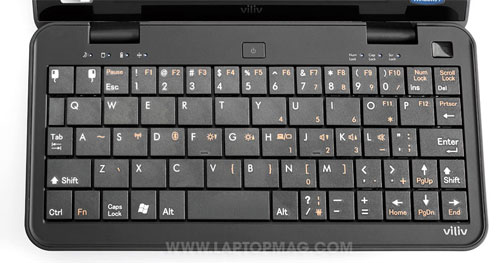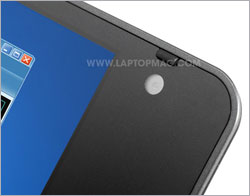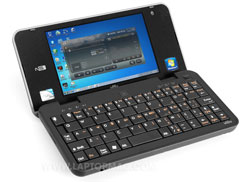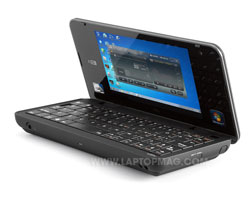Laptop Mag Verdict
Although it's on the pricey side, this pocket-size Windows PC is remarkably capable.
Pros
- +
Stylish, compact, and durable design
- +
Small keyboard provides good tactile feedback
- +
Sharp high-res screen
- +
Snappy app open times
- +
Strong video playback
Cons
- -
Expensive
- -
Mediocre Wi-Fi
- -
Poor touch experience
- -
No video output
Why you can trust Laptop Mag
At first blush, the Viliv N5 would seem the perfect device for those who feel smart phones like the Droid X and tablets like the iPad don't offer the full PC experience of running a desktop OS with all your favorite applications, but for whom netbooks are too cumbersome to tote around. This 5-inch, 1-pound system is powerful enough to run Windows 7 with all the trimmings, and even includes a webcam and optional 3G broadband. However, with a starting price of $649, the N5 doesn't come cheap, and its battery life is relatively short. So is this pocket-size Windows machine more than just a novelty?
Design
At a weight of just 1 pound and a size of 6.8 x 3.4 x 1 inches, the Viliv N5 is much larger than even the biggest superphone, but it still fit easily in the front pocket of our Dockers. Its narrow width also makes it a good device to use while standing because you can easily grip it with one hand, though you'll need both hands if you want to type or use the touchpad.
The superior build quality and elegant design of the N5 clearly gives it the look of a premium product. We couldn't help but fall in love with the soft rubberized black plastic material used on the lid, sides, bottom, and deck. Not only does this matte material look fantastic, but it makes the device remarkably easy to grip for long periods of time.
Even the hinges of the N5 have a strong, sturdy feel; they snap the lid closed with a powerful clacking noise. We normally don't test the durability of notebooks because we don't want to risk breaking them. However, while writing this review our N5 review unit accidentally fell off our desk, a distance of nearly 3 feet, and survived without any damage (though its battery popped off). Being able to survive small drops is important for a device that's meant to live in your pocket.
Heat
Throughout our testing, the N5 stayed relatively cool, which is no small feat considering that other tiny notebooks we've tested--the Sony VAIO P, for example -- had serious heat issues. After playing a Hulu video for 15 minutes at full screen, we measured the area near the touchpad at a reasonable 93 degrees Fahrenheit, the middle of the keyboard at 95 degrees, and the bottom a warmer 100 degrees. We consider temperatures above 95 degrees and below acceptable for the top surface of a notebook, and 100-degree bottoms quite typical. In this case, however, you'll barely notice the bottom's temperature because the rubberized plastic makes it so comfortable to hold.
Keyboard and Touchpad
Despite its diminutive size, the N5 sports a full QWERTY keyboard with fairly large keys that provide tactile feedback that reminded us of our favorite ThinkPad keyboards. Don't expect to do a lot of touch typing, though, because the entire device is just too narrow for an adult (or even a large child) to place one's hands on the home row.
However, with the N5 sitting on our desktop, we were able to achieve a score of 32 words per minute on the Ten Thumbs Typing Test, which is a far cry from our typical 80 word-per-minute rate, but much better than we'd do on most smart phones. Because the keys were so responsive, we had little difficulty typing when holding the N5 aloft, though our words-per-minute were in the mid-twenties when we tried the typing test in that position.
For the most part, keys appear in their typical positions, but to make them this large on a device this small, you'll notice a couple of compromises. The most awkward of these involve the placement of the colon/semicolon key, the bracket/braces keys, the hyphen key, the +/= key, and the question mark/slash key. The colon/semicolon characters, which normally sit to the right of the L key, share a button with the single/double quote characters. That means you have to hit the Fn key + quote to get the semicolon and Shift+Fn + quote to get the colon character. The brackets and braces characters, which normally have their own keys to the right of the P key, are available by hitting the Fn key + V, B, N, or M. The hyphen character, the +/= characters, and question mark/slash characters all have their own dedicated keys, but these are located to the right of the space bar, rather than in their typical QWERTY positions.

Click to enlarge
Instead of a traditional touchpad or pointing stick, the N5 has a tiny optical touch square--similar to that on the BlackBerry Bold 9650--located above the right corner of the keyboard, just above the Delete key. In the upper left-hand corner of the keyboard are dedicated keys that serve as left and right mouse buttons. While this layout may seem awkward at first glance, we found it easy to navigate around the desktop, click links in web pages, and even highlight text in Word.
Ports and Webcam

Click to enlargeOne can't reasonably expect a lot of ports on a chassis this small, and the N5 is notably sparse, offering only a single USB port, a microSD Card slot, and a headphone jack. If the N5 had a way to output VGA or HDMI, it would make a great mobile presentation device, but as it stands the lack of video-out options is a huge missed opportunity.
The N5 has a 1.3-megapixel webcam, but we were unable to produce an image larger than 320 x 240 either when shooting stills or videos. Worse still, the camera had real trouble handling florescent and low lighting. The low-light image we took at our cubicle looked really washed out, but when we moved next to a window with the sun shining through it, the picture quality improved a great deal.

Click to enlarge
Over Skype, our image appeared blurry, small, and pixelated. However, we appreciated the convenience of being able to speak on Skype as we walked around the office. The external microphone was sensitive enough to pick up our voice even when we put the notebook on a table a few feet away.
Display and Audio
The Viliv N5's 4.8-inch glossy screen is the real star of the show. For a display that's barely larger than a cell phone's, it provides reasonable viewing angles and a native resolution of 1024 x 600, similar to those found on 10-inch netbooks. The picture is incredibly sharp, colorful, and bright.
Of course, with that many pixels, the icons and text are a bit small, but we found that tweaking Windows 7's display settings to show fonts at 125 percent of their size helped a great deal. Better still, you can turn the resolution up to 1024 x 768 for even more vertical real screen real estate. Since the panel's native resolution is only 1024 x 600, though, we believe this higher setting is using interpolation to simulate that extra 168 pixels, but it allowed us to see even more of our applications and web pages.
Audio quality was decent, but volume way too low; we could barely make out the lyrics when streaming "Bulletproof" by LaRoux from Napster at full volume. However, with our headphones plugged in, sound was more than loud enough.
Touch Performance
The N5's panel is a resistive touchscreen, though its unresponsive behavior made us wish Viliv had either gone with a capacitive screen or forgotten about touch altogether. We had to press down with an awful lot of force to get the display to recognize and respond to our touches, and since all the icons, buttons, and menus are so small, it's nearly impossible to tap anything accurately. Instead of a stylus, Viliv includes a piece of plastic that looks like a guitar pick, which attaches to the device via a string. Stabbing at the screen with this pick was an exercise in futility. Since the display supports only one tap at a time, you can also forget about multitouch gestures like pinch-to-zoom. A representative from Dynamism, which sells the N5, told us that the touchscreen on the shipped models may be better than what we experienced.
Performance

Click to enlargeThe Viliv N5's 1.3-GHz Atom Z520 CPU, 1GB of RAM, internal Intel GMA 500 graphics, and relatively slow PATA SSD won't set any records, but performance was snappy on all the everyday tasks we tried, from opening apps to watching videos or speaking over Skype. However, the N5's performance on most of our benchmark tests was unimpressive, particularly when compared to netbooks.
On PCMark05, which measures overall system performance, the N5 scored a mere 1,047, which is quite a bit below the netbook category average of 1,433, though this is not a netbook . In reality, it's somewhat unfair to compare the N5 to a netbook, because it's an Ultra Mobile PC (UMPC) that requires smaller, more power-efficient components, but it is a comparison many consumers will inevitably make.
The N5's 32GB SSD booted into Windows 7 Starter in a mediocre 1 minute and 10 seconds. On the other hand, the system woke from sleep in a mere 5 seconds, so if you're using it throughout the day you may want to just keep putting it to sleep. Write performance was sluggish; it took a full 7 minutes and 51 seconds to copy 4.97GB of mixed media files, a rate of 10.8 MBps. That's significantly slower than the 17.6 MBps average for netbooks.
The SSD and the N5 itself really shined, however, when it came to opening applications. We tested it by opening three different pieces of software: Word 2010, Chrome 5.0, and Adobe Acrobat Reader 9 opening to a large PDF file. Each program was opened three different times in three different sessions, and the average was taken. It took a mere 1.2 seconds to open the Chrome browser, 2.5 seconds to open Word 2010, and only 4.9 seconds to open a 500-page PDF (the 9/11 report) in Adobe Acrobat Reader 9.
With its much slower than-a-netbook CPU, the N5 took 7 minutes and 51 seconds to transcode a 114MB MPEG-4 file to AVI using Oxelon Media Encoder. That's slower than the netbook category average of 6:24 by about 25 percent.
Graphics and Video Performance
The N5's GMA 500 Intel graphics card provided solid video playback. Using the N5, we were able to stream a 720p episode of Fringe from Fox.com at full screen with no lag issues and very sharp, colorful images. We also were able to play a 720p WMV file of a race car rolling down a speedway at full screen with no hiccups.
We navigated the globe in Google Earth and Google Earth's flight simulator, though a temporary Internet slowdown in our office--and the N5's poor throughput--was responsible for making Google Earth take a little while to download images.
While this machine works fine for media playback, we didn't even perform our standard World of Warcraft and Far Cry 2 gaming tests, because 3D gaming really is too much to ask of a system with these specs. However, the screen is certainly sharp enough to support plenty of casual games.
Battery Life and Wi-Fi

Click to enlargeThe Viliv N5 lasted 3 hours and 58 minutes on the LAPTOP Battery test, which involves continuous surfing over Wi-Fi. Considering the small size of the device and its battery, nearly 4 hours of performance seems reasonable. By comparison, the original Sony VAIO P lasted only 2:45. Still, the iPad went as long as 9:28.
The 802.11g Marvell Wi-Fi radio managed only disappointing transfer rates of 14.5 and 12.3 Mbps at distances of 15 and 50 feet from our router, respectively. A typical 802.11g netbook gets in the high teens or low 20s on 802.11g and can reach well over 30 Mbps when equipped with 802.11n. Considering that the N5 has no Ethernet port, its slow Wi-Fi is particularly disappointing.
Configurations
Currently, the Viliv N5 is available in two configurations. The $649 unit has Wi-Fi only, while the $799 version has an embedded 3G (HSPA) module that works with SIM Cards from either T-Mobile or AT&T. Given the high cost of the 3G model and the fact that this is clearly a secondary device, we'd recommend buying the less expensive Wi-Fi only version and then carrying a mobile hotspot like the MiFi or the Sprint OverDrive, which you can use with your primary notebook as well.
Software and Warranty
In addition to Windows 7 and a trial version of Norton Internet Security, Viliv bundles a few of its own utilities. Viliv Music Studio is a simple music player, and Viliv Player is for videos. Both have reasonably attractive interfaces but won't make anyone forget about Windows Media Player or iTunes. Viliv FastWeb is a web browser with larger buttons for the smaller screen, but we prefer Google Chrome or Firefox for their speed and power. Viliv Cam lets you take pictures or record video with the N5's VGA webcam. Finally, Viliv Manager is a control panel that lets you turn the Wi-Fi, embedded 3G, Bluetooth, and webcam on and off to save power.
Viliv covers the N5 with a one-year manufacturer's warranty and, when purchased through Dynamism (currently the exclusive U.S. seller), it also comes with unlimited toll-free tech support.
Verdict
With its comfortable keyboard, gorgeous design, colorful screen, strong battery life, and snappy app opens and video playback, the N5 makes a compelling argument for ultramobile PCs. You can visit any Flash-enabled web site (even Hulu) and use your favorite desktop applications, from Hootsuite for tweeting to Microsoft Office to a full browser on a device that fits in your pocket. But for $649, we wish that the N5 had a better webcam, a video-out option, and longer battery life. If you can live with these trade-offs, this UMPC is worth a look.
Viliv N5 Specs
| Bluetooth | Bluetooth 2.1+EDR |
| Brand | Viliv |
| CPU | 1.33-GHz Intel Atom Z520 |
| Card Slots | microSD |
| Company Website | www.viliv.com |
| Display Size | 4.8 |
| Graphics Card | Intel GMA 500 |
| Hard Drive Size | 32GB |
| Hard Drive Type | SSD Drive |
| Mobile Broadband | HSPA |
| Native Resolution | 1024x600 |
| Operating System | MS Windows 7 Starter |
| Ports (excluding USB) | Headphone |
| RAM | 1GB |
| RAM Upgradable to | 1 GB |
| Size | 6.8 x 3.4 x 1 inches |
| USB Ports | 1 |
| Video Memory | Shared |
| Warranty/Support | 1 year manufacturer's warranty, plus 1 year toll-free Dynamism tech support |
| Weight | 1 pound |
| Wi-Fi | 802.11b/g |

